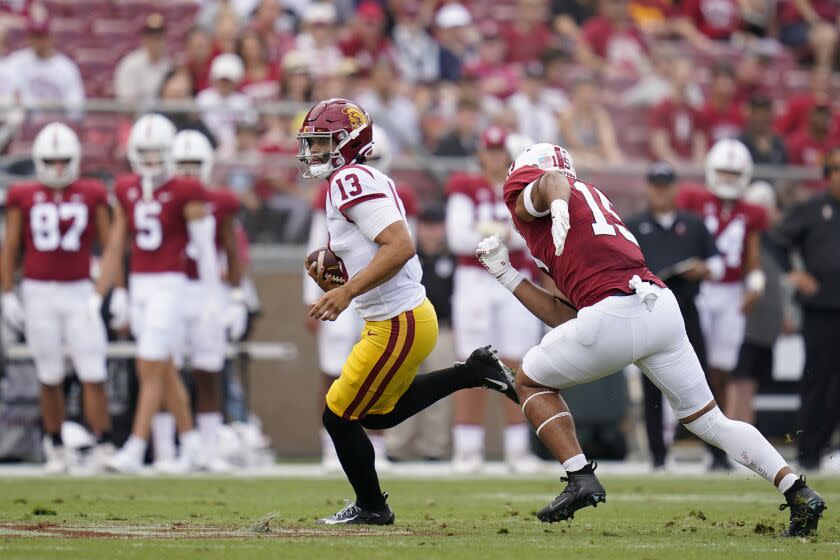Op-Ed: Football at Stanford? Maybe not

- Oops!Something went wrong.Please try again later.
After 51 years of pulling for Stanford, I rooted for its archrival USC at their game Saturday night. How odd not to celebrate when Stanford scored.
I wanted, and got, a blowout loss because it helps the case that Stanford must decide whether to continue a football program that only five years ago was among the nation’s best and is now in freefall.
As the Supreme Court, states, including California, and the NCAA clear the way for college athletes to be compensated, USC and schools like it, supported by their wealthy alumni, are seeking the best talent, increasingly stealing players from other colleges.
In trouncing Stanford 41-28, USC, coached by a newcomer from Oklahoma, was led by a quarterback and a receiver who transferred from Oklahoma, a receiver from Pittsburgh, and running backs from Oregon and … Stanford. Its leading tackler transferred from Arizona State. All told, USC has 26 transfer players; Stanford has one.
Many players transferred to USC because they think its new coach, Lincoln Riley, can take them to a championship, meaning more visibility and therefore more compensation. They can be paid more — millions, even — for appearing in advertisements, autograph signings, social media posts, videotaped greetings for fans, and more. Even if more players had confidence in Stanford’s coach, David Shaw, the university’s tougher admissions standards would make it difficult to transfer.
And Shaw says he wants it that way. “We have a different approach than our opponents today,” he said after the USC game. “We’ll never have 20 guys transfer in. We’re going to take freshmen. We’re going to take great students and great football players. We’re going to teach them. We’re going to develop them. That’s going to be our mode.”
Stanford would be lucky to win three games this 12-game season, as it did last season; many fans blame Shaw and the coaching staff. But without more talent, the school will never return to its glory days among the nation’s top five teams under Shaw five to 10 years ago, when the school regularly sent stars to the NFL — a remarkable accomplishment for a university that has avoided the scandals and academic fraud seen in other football programs. Stanford isn’t alone; as football becomes bigger business and money plays a bigger role, many universities will face the same problem.
Stanford’s extraordinarily wealthy alumni and supporters could afford to play the money game by finding many ways to compensate the players. John Doerr, the venture capitalist, just donated $1.1 billion for a school to address climate change. He and his kind, many of them running companies, could pony up to pay athletes for endorsements and appearances. Car companies and many consumer-products companies are doing it. A group of Texas Tech alumni say they will sign every scholarship player and even walk-ons to $25,000 name, image and likeness contracts; other schools’ alumni are forming similar collectives. Silicon Valley supporters could afford a lot more than those people.
But I’m guessing Doerr, and many like him, would say football is not important enough. And I assume Stanford’s president and board, who will make the decision on football, and many alumni are repelled by the commercialism and the threat to academic integrity. Not to mention that the physical dangers of the sport are clear now.
OK, fine. Then Stanford should stop competing for the BCS National Championship and instead play schools like Duke, Northwestern and Virginia. Or, to be more climate friendly by staying closer to home, Cal, UC Davis and Sacramento State.
Dropping football would further disconnect Stanford and colleges like it from the rest of America. Very likely, fewer high school seniors would apply; many like the football ambience. Yet I sense few at Stanford would mourn the loss of football, to judge by attendance.
Last Saturday night, two weeks before school starts, the student section was almost empty as the game began. But even when everyone has returned to campus, the number of students rarely exceeds a few thousand. On Saturday, the stadium was two-thirds full only because there were so many USC fans, in gold and cardinal jerseys. Stanford gave away free tickets to faculty and staff when it became clear the stadium would have many empty seats.
Even the spit-and-polish USC marching band, whose halftime show consumed most of the field, dwarfed the Stanford band, which never even took the field.
How to replace the tens of millions in football television revenue that supports Stanford’s outstanding teams in sports like tennis, swimming, water polo and volleyball? Does the university really need these sports anyway? I think so. Perhaps the wealthy donors could step up.
But in football, if the university community won’t support the athletes as competitors are doing, I’d support dropping to a lower level of play against comparable schools. Find a division where paying players and overlooking academic problems become less important. Where all the schools agree to play by the same rules. And then find alumni to support such a sports program, with far less TV revenue. Stanford would also have to negotiate a way for its other strong teams to continue to compete in the Pac-12.
It won’t be easy, but what’s clear is that right now the system is stacked against schools like Stanford. It does neither the university nor its ardent fans any good to see this inevitable collapse. What’s needed is a new way of thinking about college football and a new response.
Glenn Kramon, a 1975 graduate of Stanford, is a lecturer at the Stanford Graduate School of Business.
This story originally appeared in Los Angeles Times.

